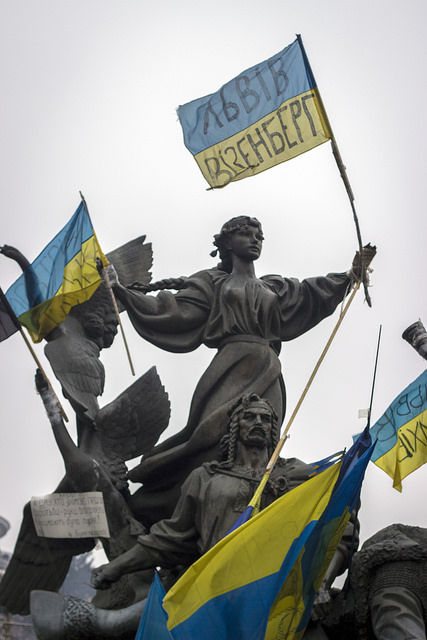The fine Canadian painter with a Ukrainian heritage, Natalka Husar (and an excellent name, too), dropped by the house Tuesday morning. We hadn’t seen each other for a while so it could only mean one thing: she’d come to celebrate, or just mark, the Ukrainian victory in Kyiv over the weekend. (Temporary and provisional, she quickly qualified.) “I brought you a book,” she said.
It’s Burden of Innocence, published in Ukraine in 2009, mostly her paintings plus brief, incisive interpretations (available at the AGO). There’s an ancient first-aid kit from a Lada shown on the cover. She says the book is her first-aid kit for Ukraine. She painted it with “dead artists’ paint,” battered tubes of toxic metallic oils, also pictured, that you can scrounge in markets there.
She paints old babas on city streets beside step-on scales, who’ll tell your weight for a few cents; they weigh, in effect, the truth and lies of what’s been happening there since the fall of the Soviet Union. The artist appears as a nurse (who probes and heals) or an anachronistic “stewardess” who guides people around and caters to them. There are many thick-necked, short-haired thugs in black; not yet the corrupt rulers but “oligarchs-in-waiting,” who ride the steep subway escalators: “up to heaven, down to hell.” And the hopeful yet soiled young girls; she sees their faces as wounds covered with makeup. She also reproduces trashy novel covers — crime or romance — with herself inserted. The work is figurative, kitschy, classically iconic, exotic yet disturbingly familiar.
She says it’s her response to the hype and nonsense after the Orange Revolution of 2004 and the inflated declarations of a new Ukraine. There were authentic elements then but also a stage-managed feel; the aftermath was oversold. Ukrainian-Canadians flocked to hail it but the thugs and sad teens proliferated along with corruption — epitomized by the deposed president’s privatization of his residence, including his own zoo. She sees last week as a reaction to the delusion and fakery she caught in the book, though in her artsy way: basically “I just push the paints around.” Then we look and it’s all there.
Her kind of finely tuned intuitive response can be invaluable in a situation as murky as Ukraine. You’d have to at least be there to make a judgment and that mightn’t help. People on the spot don’t agree nor do the many “experts.” The puffier the generalizations, the more suspect they are.
Take, for example, product from the Canadian Institute for Research into the Clash of Civilizations, sometimes called the National Post. Conrad Black, its funding father, coughed up a chestful of civilizational sputum about Ukraine last weekend, based on his insight that “All of European history since Augustan times … has been a demarcation of western and non-western influences.” That drifts some way from Husar’s thick-necked thugs riding escalators in the metro.
My problem is I don’t really believe there are stark “civilizations,” other than as a way to declare “our” superiority over “them.” It’s similar to why I don’t like “Canadian values”: a core example — public health care — was denounced as “unCanadian” just 50 years ago when it first appeared. Cultural essences tend to be highly unstable. Plus the distinctions start to fade. I agree Ukraine and Russia are kleptocracies, but that’s also true of what’s emerged among our financial classes since 2008.
Still, to avoid the National Post’s pet peeve — moral equivalency — I’ll just add that you can’t really disentangle “civilizations;” the world was always more interconnected than the clash of civs thesis allows. The Russia of today was shaped by western intervention after its 1917 revolution; and the West created itself largely in response to the result. The interactions are eternal. The “civilization” of Islam is by now largely a response to images of itself imposed by the West. It’s like the Biblical twins, Jacob and Esau, wrestling in their mother’s womb and finally emerging, one still clutching the other’s heel.
But here’s Husar, going in without analytical or demographic tools, just an intuitive sense that humans are human and can grasp each other’s foibles and mendacities. Which approach, I ask you, is a better starting point?
This article was first published in the Toronto Star.
Photo: Christiaan Triebert/flickr



